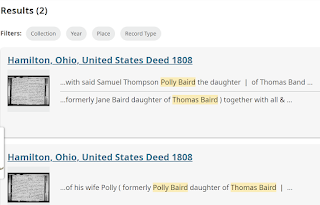%20(1).png)
Recap 1st Quarter 2025This is a Recap of the Recent Blog articles and podcast episodes. Our most recent podcast went out
4 April 2025.
Revolutionary War: Muskets to Manuscripts
On April 12, I will be presenting The Revolutionary War: Muskets to Manuscripts at Midwest Genealogy Center. This day of fun is sponsored by the Missouri State Genealogical Association (MoSGA), My topic is the Revolutionary War. This is a free hybrid class, but
Registration is required.
Accessing the HandoutThe handout for this presentation is provided at
linktr.ee/hittinthebricks (email subscription to the site is required to access the presentation handout; so subscribers only). Know we do not send out ANY publication or emails, but it does provide us with stats so we can learn if you are appreciating topics.
Feel free to provide us with feedback using the
linktr.ee/hittinthebricks site.
We also randomly issue gifts to our linktree subscribers and to donors to
TracingAncestors.org. This year, we will be giving away AncestryDNA kits. Know that the
Hittin' the Bricks podcast is sponsored by
TracingAncestors.org.
ChatGPT
What Can ChatGPT Do? Scour the internet. Where Familysearch scans the holding within the familysearch collection, ChatGPT can quickly scan the internet. Here's an example of the wonders of ChatGPT while working with a Revolutionary War Soldier case.
You will recognize this example if you attend the Musket to Manuscript Course offered 12 April 2025.
What was wonderous? Who would have thought that my biggest clue to open this research would come from a 1929 newspaper article?
Boolean, Boolean,
Boolean
When we are doing searches (newspaper, AI, ChatGPT, text, ancestry.com and familysearch.org, Knowing how to use Boolean operators is a major advantage for genealogists! It supercharges their search abilities and helps them sift through tons of information more efficiently.
You can ADD, or NOT, include information. Boolean operators (like AND, OR, NOT, and quotation marks for exact phrases) help genealogists narrow or broaden search results when using databases, archives, or even Google.
Properly creating a Boolean search can save you hours!
Be sure you are familiar with Boolean searches. Here's a chart to get you started, but I suggest taking a free online course or use ChatGPT to help you out.
Embrace AI
(The following is a reprint)
Yes, AI is now a genealogist's tool! Tool. Analysis and the burden of proof is on you! But, AI is a tool, like the old dewey decimal card catalog was in my day! I loved those days of researching and typing papers on my red typewriter that I still have.
But I digress. I will demonstrate in the Musket to Manuscript Presentation how to effectively and responsibly use the the AI feature under "Experiments" on Familysearch. It will truly ccelerate colonial / Revolutionary War era research as you make quick family trees to get to that 5-8 great-grandfather who was your Rev War Veteran.
Here is an overview for you.
(Reprint from Jun 2024 Newsletter)
Step 1: Log in using your free familysearch.org accout.
Step 2. Go to the home page by clicking on the Family Search logo on the upper left-hand coner.

Step 3. Scroll down to the far right bottom of the page and find VIEW EXPERIMENTS. Keep in mind it is in beta, so the image placements may change, but the wording has so far been the same.

Step 4. In the middle of the top row, you will see this image with Expand your search with Full Text. And Go to Experiment. Feel free to try all the buttons, but this is the one you were asking about after the last podcast.

Step 5. Start Your Search using Keywords. Trying to find relationships?


This gave 5545 returns. With both names in quotes it translates just find ever occurence of Thomas Baird and/or Polly Baird. This would allow me to gather places, timeframes, names, etc. But it's AI, I can narrow that if I need to.
Now the Search Tips give you little to work with, but here are a few suggestions.

Are you needing to narrow your search? In my wide search, I learned there are several Thomas Bairds and several Polly Bairds in Ohio. I need the correct 1) Polly Baird 2) I need to confirm her relationship with Thomas, 2) I need her to be married or widowed to a Samuel Thompson. Of, course there are times when we have to widen our search. For example, Wonder how many Thomas and Polly Bairds there are in Ohio?But I want only documents that have both names in it and the bonus if S. Thompson is also named in the same document. You can put all three in your search, but for our purpose (and my need to narrow down one step at a time), I'm showing yu how I do it.
So, I add the "+" sign before each person of interest with the "quotes.. This translates to I want all the occurences of these names in the "same" document.


Wow!That gave only two documents with them together and both documents are in Hamilton Ohio. That was a big lead for me. I wasn't sure where they had moved to/from.
Big Bonus...These documents answered all my questions. It not only named Polly, it confirmed Thomas was her father and Samuel was her husband.

Oh...and I learned the cause of my confusion

Polly Baird was the daugther of Thomas Baird by his first wife, Jane Kilgore, the daughter of Charles Kilgore of County Knox, Indiana Territory. Here's a link to the document:
bit.ly/45ydxW1
Now do you see why I love these AI tools?









%20(1).png)

















